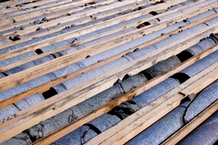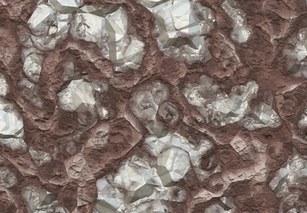|
Explorations
Explorations companies are seeking out diamonds in new regions such as:
Southern Saskatchewan has a kimberlite, which consists of a potentially diamond-bearing rock. It was discovered in the Sturgeon Lake area in 1988. Saskatchewan contains one of the largest kimberlite clusters in the world, with about 80% kimberlites being diamondiferous (containing or yielding diamonds for mining). Most diamond explorations have been in the Central and northern regions, including the kimberlite found by Shore Gold Corporation at Fort a la Corne in Saskatchewan. Even though, the kimberlites were found in these regions of Saskatchewan, much of this territory is still unexplored and could be the next major diamond area in Canada. In Malaita, Solomon Islands, the presence of micro diamonds in rocks and other minerals could lead to long term economic benefits for the Malaita province as well as the entire Solomon Islands. The ministry in Malaita will work on a paper seeking their Cabinet's approval to begin explorations in search of mineral presence there. A considerable amount of diamonds have been found in the alluvial gold operations in rivers draining the Sierra Nevada mountain range, either within the fan surrounding Sierra's Diamond Exploration locations or downstream from it.
Photo of A Kimberlite Endless Core Benitoite is a gemstone of quality proven to be a valuable find of the diamond discovery. It is an intregal part of the minerals found in Sierra Nevada. These minerals come from the crater facies eruptive, whole rock, and recent trenching within the vent parameters which contain, Cr-spinel plot-- several grains tract of land tests of chromite inclusions in a diamond. The Benitoite diamond weighed 1.4 carat and was sold for $3400. There is indication of diamondiferous kimberlite in the Hudson Bay Lowland, Manitoba, Canada. The compilation of data the Manitoba Geological Survey explains the possible presence of the kimberlite in Manitoba. According to the update as of 2003, there is no discoveries of diamondiferous kimberlite announced in Manitoba. DeBeers is The Manitoba Geological Survey will continue to search for and compile existing regional KIM (kimberlite indicator-mineral) surveys in order to provide geoscience support to the diamond exploration effort in Manitoba. This will include: compilation of KIM database, regional and detailed MGS sampling programs, resubmission of archived till samples for KIM and geochemical analysis, an assessment of till stratigraphy in the Hudson Bay Lowland and other data to show kimberlite potential in Manitoba. The "Cobalt Property" in Ontario, Canada, is a targeted area for diamond discovery. In their Press Release dated January 26, 2009, Diamond Exploration Inc. has announced that it has entered into an Agreement with International Millennium Mining Corp.("IMMC"). This agreement will give Diamond Exploration Inc. fifty-one percent (51%) interest in International Millennium Mining Corp. "Cobalt Property".The survey in this area of interest shows from previous work done including, mapping trenching, till sampling and core drilling, anomalous kimberlite minerals, such as:
Back Packing Tools for Explorations A zone of lamprophyre dykes(rare molten rock on a sheet intrusion) and lamprophyric breccias(rare molten rocks composed of sharp-angled fragments embedded in a fine-grained matrix) were found within a 600 metre wide corridor along a distance of approximately 3,000 metres. The other discoveries such as: 9.3 kilogram sample of lamprophyre core, which contained 4 macro- diamonds of 1.36mm (largest fine), 1.20mm by 1.12mm and 91 macro-diamonds from a multi-phased xenolith-bearing lamprophyre system, approximately 6 metres wide in its surface exposure, makes this diamond exploration a definite project for these two companies.
Diamond Stones discovered inside a Mine Sky Diamonds Sky Diamonds or commonly known as Space Diamonds are relatively still new to us. Astronomers at the Harvard-Smithsonian Center for Astrophysics discovered the largest Diamond in the galaxy in space. This 10 billion trillion trillion carat monster is made of crystallized carbon 50 light-years away from the Earth in the constellation Centaurus. A light-year is the distance light travels in a year or about 6 trillion miles. The Space Diamond is 2,500 miles across and weighs 5 million trillion trillion pounds. "Some people refer to it as 'Lucy' in a tribute to the Beatles' song 'Lucy in the Sky with Diamonds'", said an astronomer for the Harvard-Smithsonian Center for Astrophysics. The huge cosmic gem is a crystallized white dwarf. The white dwarf is the hot core of a star, left over after a star uses up its nuclear fuel and dies. It is mostly made of carbon and is coated with a thin layer of hydrogen and helium gases. So diamonds are treasures that had been found in outer space from stars that became extinct and in some meteorites which falls to Earth each year, as well as, treasures that are found on Earth. From Explorations Back To Home Page
|








